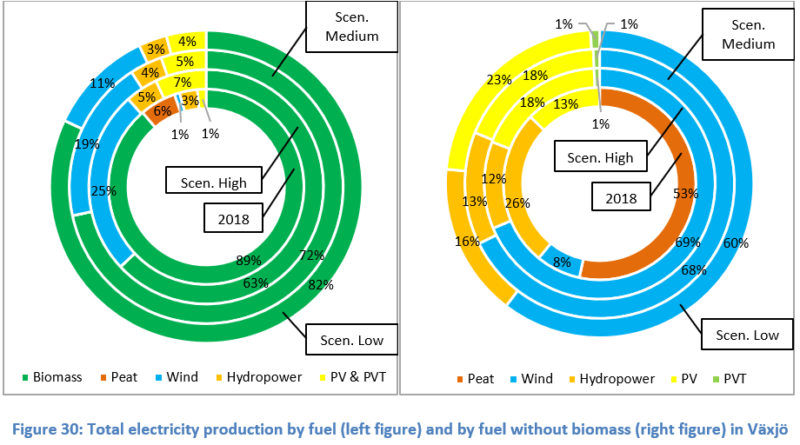Strategic development and possible policy measures
The report describes scenarios to integrate the demonstration-projects into the ongoing city development planning process on the base of the READY objectives for Aarhus (Denmark) and Växjö (Sweden). The READY objectives include energy efficiency gains of buildings and of the local district heating and cooling grids and the increase of the use renewable energy sources, for example PV, PVT and heat pumps. Moreover, the READY objectives include heat recovery systems, storages and the CO2-neutrality of the district heating supply. In order to assess the overall impact of the achieved results relative to the baseline, environmental, energy, economic and national performance indicators are considered.
The conclusion is that READY objectives can be achieved in both cities. The different scenarios assessed for Aarhus and Växjö show that biomass has a big impact on the energy supply in the future and a transformation to a higher share in the energy mix of renewable energy sources is possible. Fossil fuel “Coal & Derived” can be completely substituted by renewable energy sources. Furthermore, CO2-neutrality of the district heating supply in both cities by the substitution of fossil fuels mainly by biomass is possible. In each sector (Residential, industry, service and transport sector) due to the implantation of energy measures the total energy demand will decrease in both cities in the future. The energy demand of the residential and the service sector in Aarhus and Växjö will be mainly covered by electricity and district heating. The share of E-Vehicles in the transport sector are different in both cities. In the best-case scenario (“High scenario”), Växjö has a share of E-mobility of about 37% and Aarhus of about 27%. In addition, Växjö has the ambition to use more biofuel in the future to reduce gasoline consumption. In fact, in the High scenario, biofuel reach a share of 67% of the energy demand of the transport sector in this municipality.
Fuel switch in the energy supply of Aarhus and Växjö, generates a reduction of CO2-emissions in all scenarios being lower than the current Status Quo (available data from 2018). In the High scenario of Aarhus, CO2-emissions reduction in the service and residential sector are due the high share of electricity and district heating in the energy demand which is about 75% and 55% lower than the Status Quo. In Aarhus, total CO2– emission- savings are in best case 38% compared to the Status Quo. In Växjö, in a similar way than in Aarhus a high CO2– emissions reduction is possible in the service and residential sector. In the best-case scenario, the CO2– emission-savings are lower in the residential sector about 95% and in the service sector 90% compared to the Status of quo. in parallel, switching fossil fuels to biofuel and electricity allows reductions, in the best case about 57% of CO2– emissions in the transport sector. This gives that in total, Växjö can save 63% of the CO2– emissions in best case. In an economical aspect, in all the scenarios of Aarhus and Växjö a lower “Energy per GDP” and “CO2 per GDP” can be achieved compared to the Status Quo.
The most important recommendations to local governments are, that each city must adopt a strong governance towards energy efficiency and sustainability. Moreover, the inhabitants or rather the tenants should be convinced on the positive impacts of the installed technologies and of the retrofitting of buildings by the communication of their positive aspects (e.g.: higher living comfort). Low temperature district heating and waste heat utilization should be part of the energy supply and climate strategy by local authorities and should be integrated in urban development projects. In case of a higher share of E-mobility, it is important, that each city develops standards and promotes interoperability for drivers and charging network operators to achieve a market growth.
The general recommendations are to build well-insulated and robust buildings to minimize the need of energy consumption and to increase the economic feasibility of waste-water heat recovery systems. Moreover, in the transport sector it is important to convince drivers to switch from a fossil-fuel car to an electric vehicle and that the digital interfaces when charging an electric vehicle, must be intuitive. The most important general recommendation is to setup new collaborations between energy companies, consultants and government bodies including co-creating and design thinking involving end users and regulatory sand boxes.
Want to know more?
Deliverable no. D.7.4 Strategic development and possible policy measures
Please contact: Ghazal Etminan, AIT Austrian Institute of Technology GmbH

